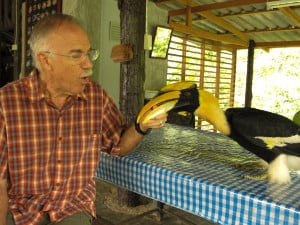Bats and Agriculture: Our 2025 Join the Nightlife Workshop
Our fourth annual Join the Nightlife workshop, held in Central Texas, brought together conservationists, researchers, and farmers from around the U.S. to explore the many
Our destination was Hala Bala Wildlife Sanctuary to seek and, hopefully, photograph the world’s largest insectivorous bat: the Naked Bat, Cheiromeles torquatus.

We were met at the Narathiwat Airport by Pipat Soisook, Curator of Mammals at the Princess Maha Chakri Sirindhorn Natural History Museum, and Sunate Karapan, Director of the Hala Bala Research Station.
The research center’s lodging was spacious and comfortable, and we had it all to ourselves, since the usual clientele of researchers were staying away, we were told, due to violence in surrounding areas.
This background about the violence came from the Lonely Planet’s guide to Thailand: Over 100 years ago, the Kingdom of Siam conquered this area, but an Islamic separatist group wanted to secede from Buddhist Thailand, and independence is still an issue today. Foreigners are not the targets, but can be in danger, as when a market was bombed just prior to our arrival.
The Hala Bala Wildlife Sanctuary was one of the few places where we could reliably find the rarely seen Naked Bat. It was an exciting place to work, where we could potentially run into a tiger, leopard, sun bear or a King Cobra. In the early morning, we were often serenaded by gibbons while eating breakfast. At mealtime, we had to contend with a pet Great Hornbill named Wang, a bird the size of an eagle who tried to dive-bomb us or rob our food, especially his favorite: roti, a type of flatbread.

Next I’ll tell you about our experiences netting and photographing 18 species of bats, including photos of Naked Bats as well as very cute and tiny Spotted-Winged and Tailless Fruit Bats.
Love our content? Support us by sharing it!
Our fourth annual Join the Nightlife workshop, held in Central Texas, brought together conservationists, researchers, and farmers from around the U.S. to explore the many
Bats are among the most fascinating yet misunderstood creatures in the natural world, and for many conservationists, a single experience can ignite a lifelong passion
Merlin and MTBC team members spent 19 days in Costa Rica last November on a filming trip for “Bat City” with its Director and Emmy
Bats can use sounds in many complex ways. They can sing and even have different dialects… When imagining a bat, the first thoughts that come
2024 © Merlin Tuttle’s Bat Conservation. All rights reserved.
Daniel Hargreaves is a lifelong bat conservationist who has worked globally to facilitate progress, including co-founding Trinibats, a non-profit bat conservation organization in Trinidad. He has organized and led field workshops worldwide, including five for MTBC. Following a long and successful career in business, he now manages a network of bat reserves for the Vincent Wildlife Trust in the UK, supervising research and development of new and innovative conservation techniques. Daniel also is one of the world’s premier bat photographers.
Madelline Mathis has a degree in environmental studies from Rollins College and a passion for wildlife conservation. She is an outstanding nature photographer who has worked extensively with Merlin and other MTBC staff studying and photographing bats in Mozambique, Cuba, Costa Rica, and Texas. Following college graduation, she was employed as an environmental specialist for the Florida Department of Environmental Protection. She subsequently founded the Florida chapter of the International DarkSky Association and currently serves on the board of DarkSky Texas. She also serves on the board of Houston Wilderness and was appointed to the Austin Water Resource Community Planning Task Force.
Michael Lazari Karapetian has over twenty years of investment management experience. He has a degree in business management, is a certified NBA agent, and gained early experience as a money manager for the Bank of America where he established model portfolios for high-net-worth clients. In 2003 he founded Lazari Capital Management, Inc. and Lazari Asset Management, Inc. He is President and CIO of both and manages over a half a billion in assets. In his personal time he champions philanthropic causes. He serves on the board of Moravian College and has a strong affinity for wildlife, both funding and volunteering on behalf of endangered species.